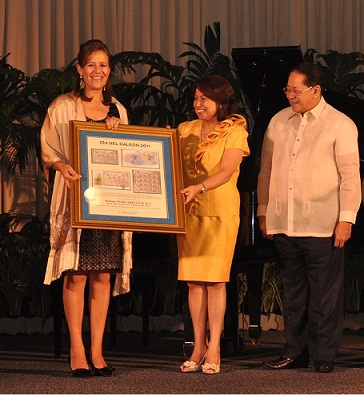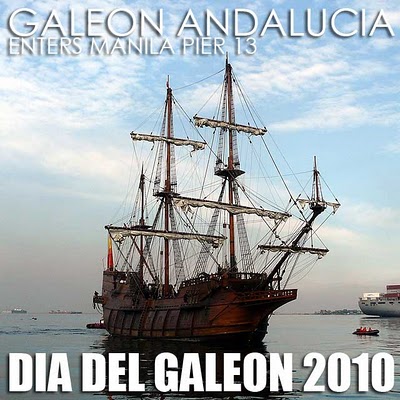
Madam Zavala, wife of President Felipe Calderon of Mexico, was here on a two-day visit last week.
At the cultural gala in her honor hosted by Sen. Edgardo Angara held at the Philippine International Convention Center last Thursday, Zavala shared her excitement after reading Jose Rizal’s “Ultimo Adios.” “He wrote it in Spanish!,” she said underscoring the affinity of Mexico and the Philippines in the Spanish language.
She said to the mostly English-speaking audience, “”I know you speak in English but your heart is still in Spanish. “
Zavala, a lawyer and was a member of the Mexican parliament, also observed that Philippine handicrafts are very much similar to Mexican handicrafts. “I’m sure the reason for this similarity goes back to the Galleon,” she said.
The galleon is a large, multi-decked ship used primarily by European states from the 16th to 18th centuries. Galleon sailed across the world bringing goods – spices, silk, silver, etc. in what is known as the Galleon Trade.
The Manila-Acapulco (Mexico) trade route, which was active for 250 years (1565-1815), planted the seed of Philippine-Mexico relations which Madame Zavala would like to bring to a higher level.
“This project will surely have the support of countries such as Mexico, Spain, China and the United States among others,” she added.

“The Galleon Trade enabled Spain –the Philippine and Mexico’s former colonizer – to participate in the highly lucrative Silver-Silk Trade, “he said.
However, Angara said, silk and silver were not the only goods traded through Manila and Acapulco. “The interchange through more than two centuries was equally cultural as it was economic, if not more so. Traditions, institutions and ideas traveled with the mighty galleons together with goods and products.”
The barong tagalog, cockfighting, the harana (serenade), the Nov. 1 tradition of Dia Los Muertos (day of the dead); and Simbang Gabi are just some of the Mexican traditions that have also part of Filipino lifestyle.
The Philippines has made a name not only as modern seafarers and shipbuilders. Those can also be attributed to the legacy of the Galleon.
Angara said ,”Perhaps the most important contribution of Filipinos o the galleon Trade was the galleons themselves, built with Philippine hardwood in the shipyards of Pangasinan, Cavite, Marinduque,Albay, Camarines and Masbate. Filipino seafarers are the most able, in demand today as they were for navigating the galleons through the Pacific.”
Last October, a Mexican- built replica of the Galleon visited the Philippines after it was shown in the Shanghai Expo.
The Dia del Galleon commemorative stamps were also launched during the cultural gala.
As a result of the re-invigorated Philippine-Mexican relations, credited to Madam Zavala, Angara said two Filipino students are in Mexico doing a study on the Galleon.
It’s awesome to imagine the wealth of information that can be learned from the Galleon trade. “The glory of the past offers us lessons on how to move forward cooperatively, capitalizing on kinship forged and strengthened through the centuries, ” Angara said.
Meron pang isang common denominator ang Pilipinas at Mexico na umiiral pa din sa ngayon, boksing.
Nagkaroon na rin ng pagkakataon na mabangit ang kaugnayan ng bansang Pilipinas sa bansang Mexico. Hindi lamang maraming maitutulad na maraming bagay ang Pilipinas sa Mexico kundi sa mga ibang bansa din sa Gitna and Timog Amerika, gayundin sa bansang Republica Dominicana at Puerto Rico. Ang damit panglalaki na “guayabera” ay katulad ng Pilipino “barong”. Sa mga pagkain ay marami din ang natutulad gaya ng “adobo”, “menudo”, “longaniza”, “chorizo”, “flan” (plan sa Pilipino”) at marami pang iba. Hindi lamang mga pangalan ang nakuha natin sa mga espanoles, pati na rin ugali at paniniwala. Ayawin man natin at subukin kalimutan, hindi maalis ang bahid ng mga espanoles at latino sa bansang Pilipinas. Marami sa Pilipino na ang pagiisip ay tulad sila ng mga taga
Hilagang America kahit na limampung taon lamang silang sinakop ng mga ito. Marahil malaki ang galit ng karamihan sa mga Espanoles dahil matagal na pagsakop sa Pilipinas. Maliban sa mga chabacanos, mayroon pa rin mga Pilipino na hindi ikinahihiya ang pagiging bahaging “hispano”. “Somos hermanos y hermanas, no importa cómo nos parecemos.” (We are brothers and sisters, no matter how we look like)
Bagamat marami tayong naging kaugnayan sa ibang lahi, pinakita at pinatunayan parin nating mga pilipino kung gaano tayo kagaling sa ibat ibang larangan.subalit marami sa atin ang mas gustong tumulad sa ibang taga nasyon.nakakalungkot ding isipin na tayo mismo ang nakakalimot sa ating pinagmulan at sa ating kasaysayan. marami tayong pwedeng ipamana sa susunod na henerasyon,isa na dito ang patuloy na pagkilala at pag aaral sa ating kasaysayan.
http://discoverph.com/out-and-about/activity-to-do/museums/visit-philippine-museums/
estoy de acuerdo,Manachito but pls.use F as in Filipino not p as in parrot.
🙂 Gracias, “Patria Adorada”. Voy a hacer precisamente eso. Estaba mostrando la forma en que se escribe en tagalo. (Salamat. patria adorada. Pinakikita ko lamang ko paano isinusulat ito sa tagalog.)
Mein Spanisch ist nicht sehr gut, so ich auf Deutsch schreiben